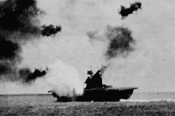
|
Dec. 7, 1941 - Carrier aircraft of the Japanese Imperial Navy launched a devastating attack on Pearl Harbor and on the military and air installations in the area. The three aircraft carriers of the Pacific Fleet were not present. USS Saratoga (CV 3), just out of overhaul, was moored at San Diego. USS Lexington (CV 2) was at sea about 425 miles southeast of Midway toward which she was headed to deliver a Marine Scout Bombing Squadron. USS Enterprise (CV 6) was also at sea, about 200 miles west of Pearl Harbor, returning from Wake Island where she had delivered a Marine Fighter Squadron. Expanded information |

|
Feb. 1, 1942 - Task Forces 8 (under Vice Adm. William F. Halsey) and 17 (under Rear Adm. Frank J. Fletcher, built around the carriers Enterprise and Yorktown, attacked the Japanese installations on the islands of Wotje, Kwajalein, Jaluit, Makin, and Mili in the Marshall and Gilbert Islands. This was the first U.S. aircraft carrier offensive. |
|
Feb. 27, 1942 - Early in the morning, USS Langley (AV 3) rendezvoused with her antisubmarine screen, USS Whipple (DD 217) and USS Edsall (DD 219) near Tjilatjap, Java. At 1140, nine twin-engine Japanese bombers attacked her. The first and second strikes were unsuccessful, but during the third strike, Langley took five hits. Aircraft topside burst into flames, steering was impaired, and the ship took a 10 degree list to port. Unable to negotiate the narrow mouth of Tjilajap Harbor, Langley went dead in the water as inrushing water flooded her main engines. At 1332, the crew was order to abandon ship, and shortly after all were clear, the two destroyers fired 4-inch shells and two torpedoes into her and she sunk about 75 miles south of Tjilatjap. Sixteen crew were lost. |
 |
Apr. 18, 1942 - Army Lieut. Col. James H. Doolittle, taking off from USS Hornet (CV 8), Capt. Marc A. Mitscher commanding, bombed Tokyo, the first American air strike against the Japanese homeland. Hornet's mission was kept an official secret for a year; until then President Roosevelt referred to the origin of the Tokyo raid only as "Shangri-La." Expanded information |

|
May 4-8, 1942 - The Battle of the Coral Sea. In the first naval engagement of history fought without the opposing ships making contact, U.S. carrier forces stopped a Japanese attempt to land at Port Moresby by turning back the covering carrier force. In the battle, the japanese lost the light carrier Shoho and the U.S. lost the carrier, USS Lexington (CV 2). Expanded information |

|
Jun. 3-6, 1942 - The Battle of Midway. A strong Japanese thrust to occupy Midway Island was led by a four-carrier Mobile Force, supported by heavy units of the Japanese First Fleet. Also, a diversionary carrier raid was launched against Dutch Harbor in the Aleutian Islands. The Japanese attack on Midway was met by a greatly outnumbered U.S. carrier force composed of Task Force 17 with USS Yorktown (CV 5) and Task Force 16 with USS Hornet (CV 8) and USS Enterprise (CV 6). In the ensuing battle, the four large Japanese carriers were sunk, carrying with them 258 planes along with a high percentage of Japan's most highly trained and battle-experienced carrier pilots, a blow to Japan from which she could not recover. Midway was the turning point of the war in the Pacific.Expanded information |

|
Jun. 15, 1942 - USS Copahee (CVE 12), Cmdr. J. G. Farrell in command, commissioned at the Puget Sound Navy Yard, the first of 10 escort carriers of the Bogue class. |

|
Aug. 12, 1942 - USS Wolverine (IX 64) commissioned at Buffalo, N.Y., Cmdr. G. R. Fairlamb, commanding. Wolverine and USS Sable (IX 81), commissioned May 1943, were Great Lakes excursion ships converted for aviation training . Sailing Lake Michigan, they provided flight decks on which hundreds of student aviators qualified for carrier landings and many flight deck crews received their first practical experience in handling aircraft aboard ship. |
|
Aug. 20, 1942 - The designation of escort carriers was changed from AVG to ACV. |
 |
Aug. 24, 1942 - USS Santee (ACV 29), under the command of Capt. W. D. Sample, was placed in commission at the Norfolk Navy Yard, the first of four escort carriers of the Sangamon class, converted from Cimarron class fleet oilers. |
 |
Sept. 15, 1942 - USS Wasp (CV 7), under the command of Capt. Forrest P. Sherman, is torpedoed by a Japanese submarine southeast of San Cristobal Island and sinks with a loss of 193 killed and 366 wounded. Expanded information. |

|
Oct. 26, 1942 - The Battle of the Santa Cruz Islands resulted in a tactical victory for Japan, but a strategic one for the U.S. in that Japan was unable to dislodge American forces off Guadalcanal. While the Japanese suffer no losses, USS Hornet (CV 8) was sunk. Damaged were the Japanese carrier Zuiho and the carrier Shokaku, and the cruiser Chikuma. Expanded information. |

|
Dec. 31, 1942 - USS Essex (CV 9), Capt. D. B. Duncan commanding, was placed in commission in Norfolk, Va., the first of 17 ships of her class commissioned during World War II. |












